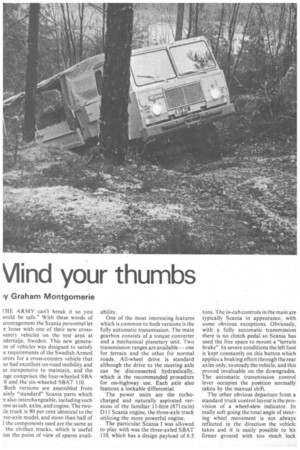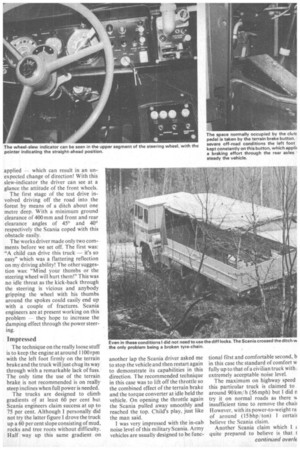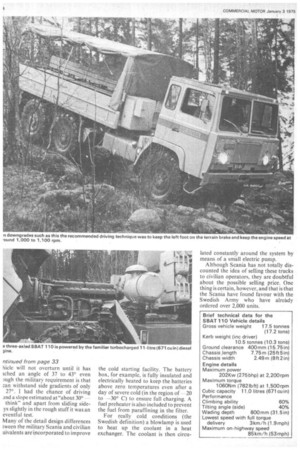Vlind your thumbs
Page 34

Page 35

Page 36

If you've noticed an error in this article please click here to report it so we can fix it.
iv Graham Montgomerie IFIE ARMY can't break it so you iould be safe." With these words of icouragement the Scania personnel let e loose with one of their new cross)untry vehicles on the test area at adertalje, Sweden. This new genera)n of vehicles was designed to satisfy Le requirements of the Swedish Armed Drees for a cross-country vehicle that so had excellent on-road mobility and as inexpensive to maintain, and the nge comprises the four-wheeled SBA 0 and the six-wheeled SBAT 110. Both versions are assembled from ainly "standard" Scania parts which e also interchangeable, including such :ms as cab, axles, and engine. The two:le truck is 90 per cent identical to the ree-axle model, and more than half of I the components used are the same as the civilian trucks, which is useful om the point of view of spares avail ability.
One of the most interesting features which is common to both versions is the fully automatic transmission. The main gearbox consists of a torque converter and a mechanical planetary unit. Two transmission ranges are available — one for terrain and the other for normal roads. All-wheel drive is standard although the drive to the steering axle can be disconnected hydraulically, which is the recommended procedure for on-highway use. Each axle also features a lockable differential.
The power units are the turbocharged and naturally aspirated versions of the familiar I1-litre (671 cu in) D11 Scania engine, the three-axle truck utilizing the more powerful engine.
The particular Scania I was allowed to play with was the three-axled SBAT 110, which has a design payload of 6.5 tons. The in-cab controls in the main are typically Scania in appearance, with some obvious exceptions. Obviously, with a fully automatic transmiSsion there is no clutch pedal so Scania has used the free space to mount a "terrain brake". In severe conditions the left foot is kept constantly on this button which applies a braking effort through the rear axles only, to steady the vehicle, and this proved invaluable on the downgrades. The automatic transmission control lever occupies the position normally taken by the manual shift.
The other obvious departure from a standard truck control layout is the provision of a wheel-slew indicator. In really soft going the total angle of steering wheel movement is not always reflected in the direction the vehicle takes and it is easily possible to hit firmer ground with too much lock applied — which can result in an unexpected change of direction! With this slew-indicator the driver can see at a glance the attitude of the front wheels.
The first stage of the test drive involved driving off the road into the forest by means of a ditch about one metre deep. With a minimum ground clearance of 400 mm and front and rear clearance angles of 45° and 40° respectively the Scania coped with this obstacle easily.
The works driver made only two comments before we set off. The first was: "A child can drive this truck — it's so easy" which was a flattering reflection on my driving ability! The other suggestion was: "Mind your thumbs or the steering wheel will hurt them!" This was no idle threat as the kick-back through the steering is vicious and anybody gripping the wheel with his thumbs around the spokes could easily end up with a couple of fractures. Scania engineers are at present working on this problem they hope to increase the damping effect through the power steering.
Impressed
The technique on the really loose stuff is to keep the engine at around I I 00 rpm with the left foot firmly on the terrain brake and the truck will just chug its way through with a remarkable lack of fuss.' The only time the use of the terrain brake is not recommended is on really steep inclines when full power is needed.
The trucks are designed to climb gradients of at least 60 per cent but Scania engineers claim success at up to 75 per cent. Although I personally did not try the latter figure I drove the truck up a 60 per cent slope consisting of mud, rocks and tree roots without difficulty. Half way up this same gradient on another lap the Scania driver asked me to stop the vehicle and then restart again to demonstrate its capabilities in this direction. The recommended technique in this case was to lift off the throttle so the combined effect of the terrain brake and the torque converter at idle held the vehicle. On opening the throttle again the Scania pulled away smoothly and reached the top. Child's play, just like the man said.
I was very impressed with the in-cab noise level of this military Scania. Army vehicles are usually designed to be func tional fil-st and comfortable second, b in this case the standard of comfort w fully up to that of a civilian truck with extremely acceptable noise level.
The maximum on highway speed this particular truck is claimed to around 90 km/ h (56 mph) but I did ti try it on normal roads as there A insufficient time to remove the chaii However, with its power-to-weight ra of around (15 bhp! ton) I certaii believe the Scania claim.
Another Scania claim which I quite prepared to believe is that t continued overle hide will not overturn until it has tched an angle of 37 to 430 even )ugh the military requirement is that can withstand side gradients of only 27°. I had the chance of driving Ind a slope estimated at "about 30° — think" and apart from sliding sideys slightly in the rough stuff it was an eventful test.
Many of the detail design differences tween the military Scania and civilian 11 ivalents are incorporated to improve the cold starting facility. The battery box, for example. is fully insulated and electrically heated to keep the batteries above zero temperatures even after a day of severe cold (in the region of —20 to –30° C) to ensure full charging. A fuel preheater is also included to prevent the fuel from paraffining in the filter.
For really cold conditions (the Swedish definition) a blowlamp is used to heat up the coolant in a heat exchanger. The coolant is then circu lated constantly around the system by means of a small electric pump.
Although Scania has not totally discounted the idea of selling these trucks to civilian operators, they are doubtful about the possible selling price. One thing is certain, however, and that is that the Scania have found favour with the Swedish Army who have already ordered over 2,000 units.
Brief technical data for the SBAT 110 Vehicle details Gross vehicle weight 17.5 tonnes (17.2 tons)












































































